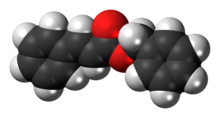Benzyl cinnamate
 | |
 | |
| Names | |
|---|---|
| Preferred IUPAC name Benzyl (2E)-3-phenylprop-2-enoate | |
| Other names Benzyl cinnamate Cinnamein Benzyl cinnamoate Benzyl 3-phenylpropenoate 3-Phenyl-2-propenoic acid phenylmethyl ester Cinnamic acid benzyl ester | |
| Identifiers | |
CAS Number |
|
3D model (JSmol) |
|
| ChemSpider |
|
| ECHA InfoCard | 100.002.827 |
PubChem CID |
|
| UNII |
|
CompTox Dashboard (EPA) |
|
InChI
| |
| |
| Properties | |
Chemical formula | C16H14O2 |
| Molar mass | 238.286 g·mol−1 |
| Appearance | White to pale yellow solid[1] |
| Melting point | 34–37 °C (93–99 °F; 307–310 K)[2] |
| Boiling point | 195–200 °C (383–392 °F; 468–473 K) 5 mmHg[2] |
Solubility in water | Insoluble[1] |
| Solubility in ethanol | 125 g/L |
| Solubility in glycerin | Insoluble |
| Solubility in propylene glycol | Insoluble |
Except where otherwise noted, data are given for materials in their standard state (at 25 °C [77 °F], 100 kPa). Infobox references | |
Chemical compound
Benzyl cinnamate is the chemical compound which is the ester derived from cinnamic acid and benzyl alcohol.
Natural occurrence
Benzyl cinnamate occurs in Balsam of Peru and Tolu balsam, in Sumatra and Penang benzoin, and as the main constituent of copaiba balsam.[3] It is used as an ingredient in the medicated cream product Sudocrem.[4]
Synthesis
Benzyl cinnamate can be prepared by heating benzyl chloride and excess sodium cinnamate in water to 100–115 °C or by heating sodium cinnamate with an excess of benzyl chloride in the presence of diethylamine.[3]
Uses
Benzyl cinnamate is used in heavy oriental perfumes and as a fixative.[5] It is used as a flavoring agent.[3]
It is used pharmaceutically as an antibacterial and antifungal.[6]
References
- ^ a b "Specifications for Flavourings". Food and Agriculture Organization. Archived from the original on 2015-09-24. Retrieved 2014-02-20.
- ^ a b "Benzyl cinnamate". Sigma-Aldrich.
- ^ a b c George A. Burdock (2010), "BENZYL CINNAMATE", Fenaroli's Handbook of Flavor Ingredients (6th ed.), CRC Press, pp. 147–148
- ^ "Sudocrem Antiseptic Healing Cream - Summary of Product Characteristics (SmPC) - (emc)". www.medicines.org.uk. Retrieved 11 June 2021.
- ^ Karl-Georg Fahlbusch; et al. (2007), "Flavors and Fragrances", Ullmann's Encyclopedia of Industrial Chemistry (7th ed.), Wiley, p. 59
- ^ Korošec, B.; Sova, M.; Turk, S.; Kraševec, N.; Novak, M.; Lah, L.; Stojan, J.; Podobnik, B.; Berne, S.; Zupanec, N.; Bunc, M.; Gobec, S.; Komel, R. (2014). "Antifungal activity of cinnamic acid derivatives involves inhibition of benzoate 4-hydroxylase (CYP53)". Journal of Applied Microbiology. 116 (4): 955–966. doi:10.1111/jam.12417. ISSN 1365-2672. PMID 24314266.
External links
- Benzyl cinnamate at National Library of Medicine's Toxicology Data Network












